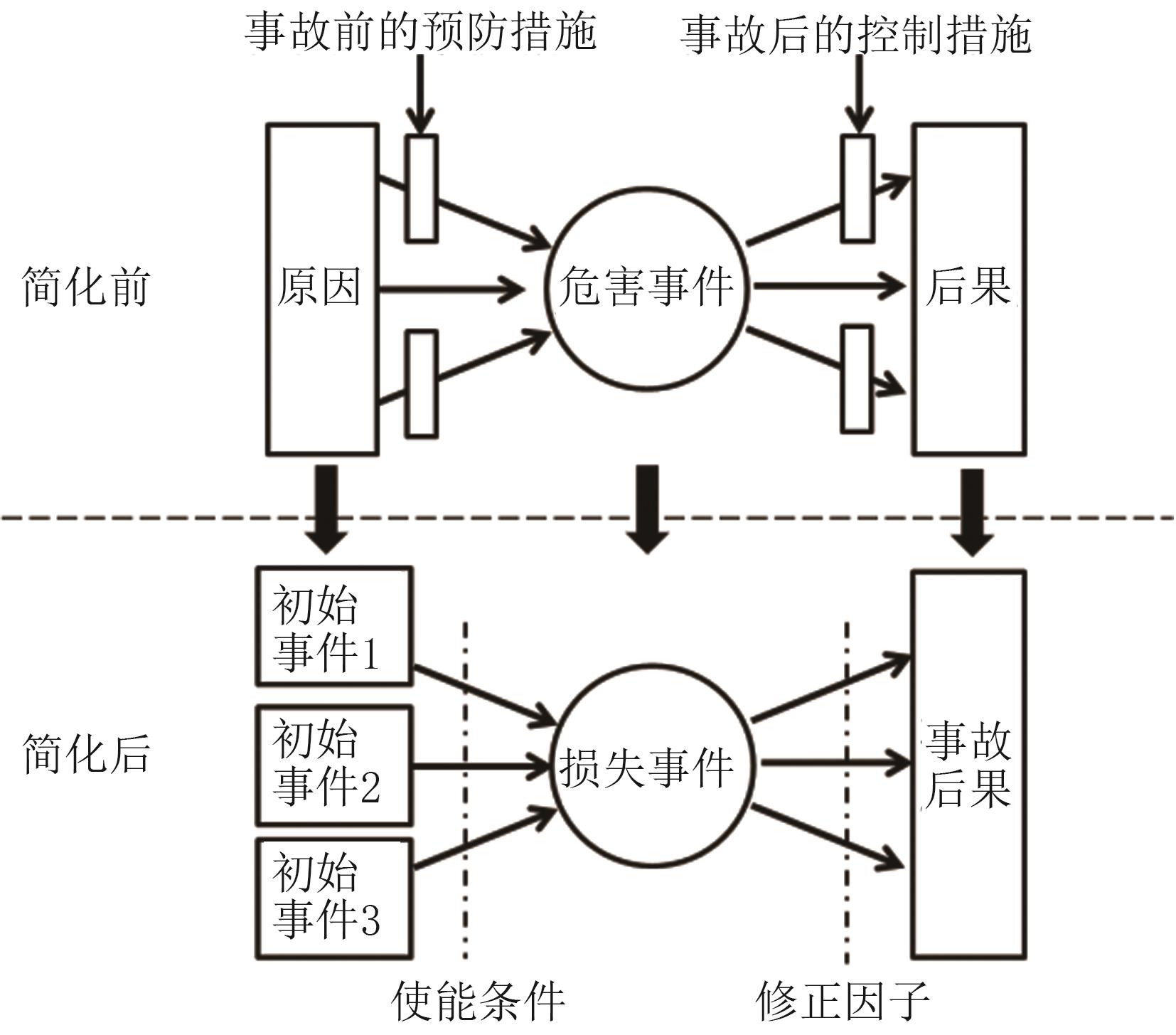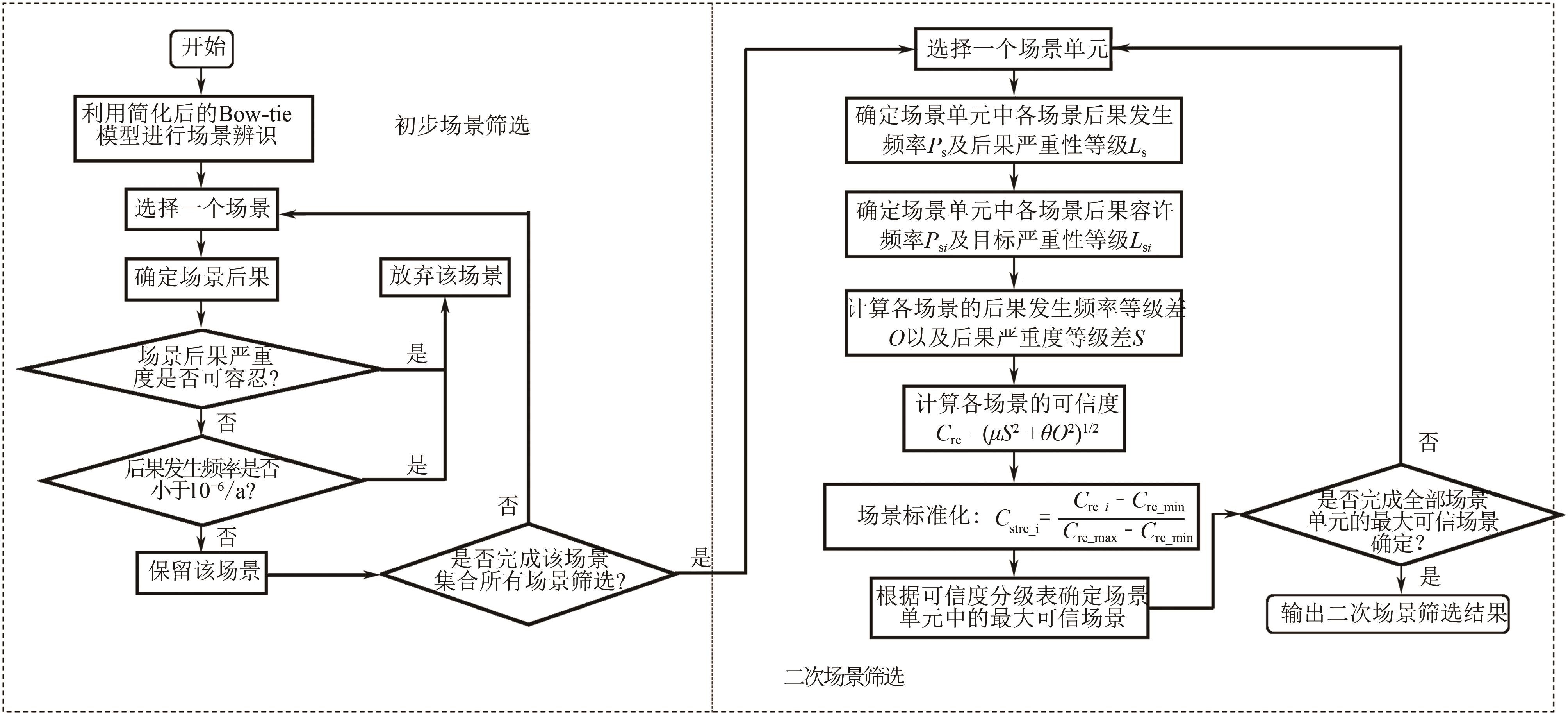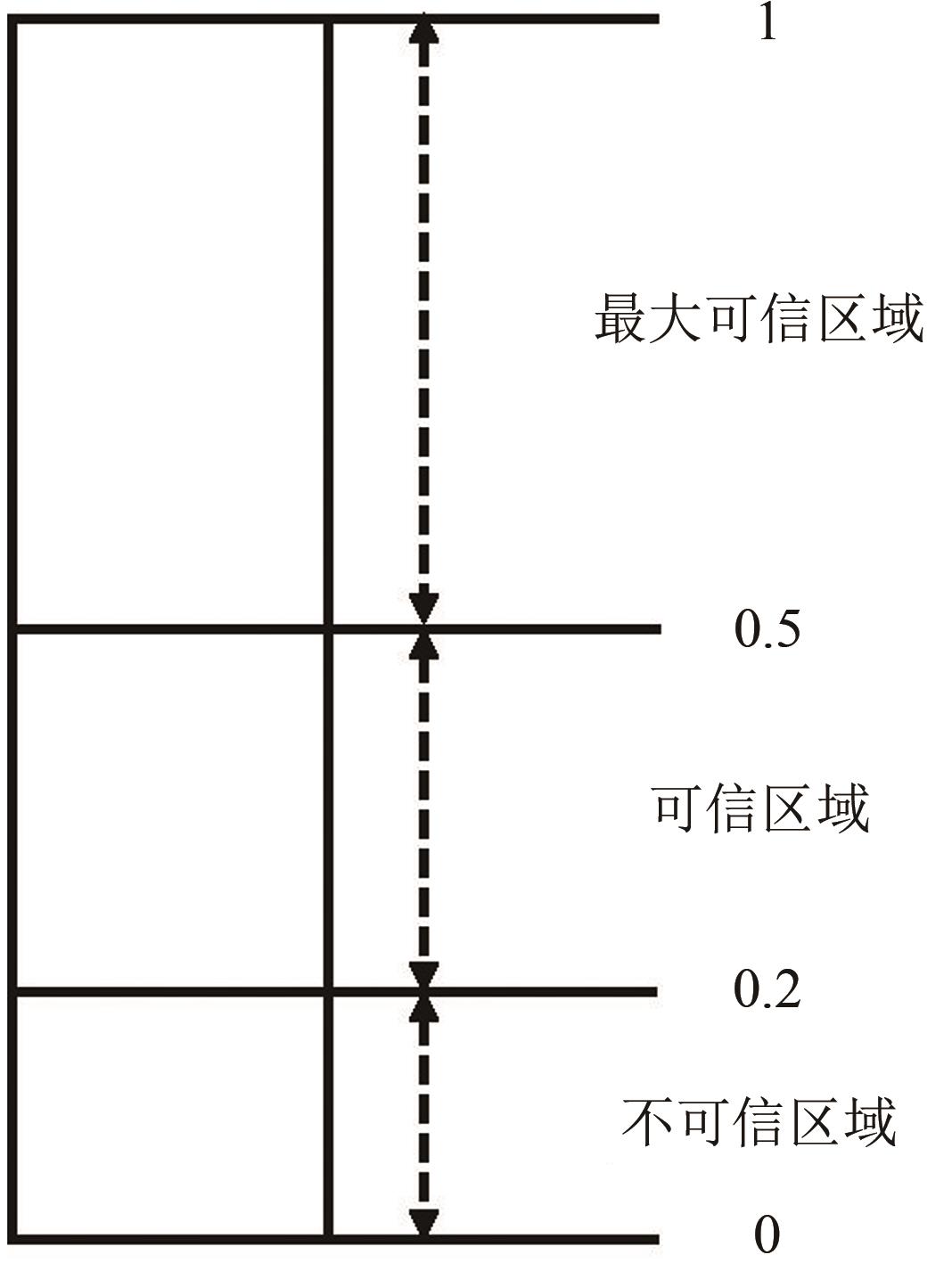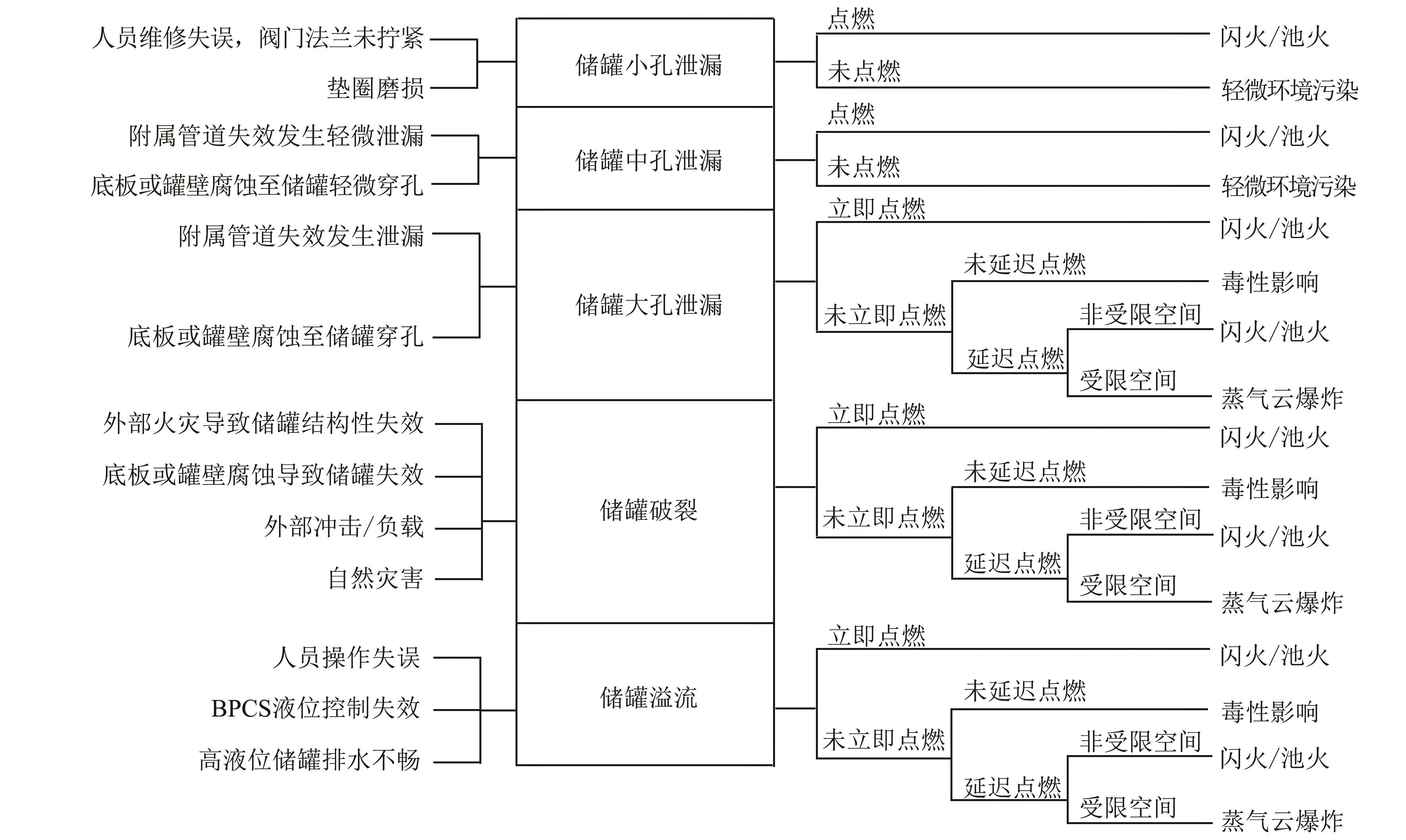Chemical Industry and Engineering Progress ›› 2021, Vol. 40 ›› Issue (11): 5988-5997.DOI: 10.16085/j.issn.1000-6613.2020-2385
• Chemical processes and equipment • Previous Articles Next Articles
Research on LOPA scenarios identification and screening based on simplified Bow-tie model
LIU Meichen1( ), LIU Peng2, WANG Haiqing1(
), LIU Peng2, WANG Haiqing1( ), LIU Yin1
), LIU Yin1
- 1.Department of Safety Science & Engineering, China University of Petroleum, Qingdao 266580, Shandong, China
2.PipeChina Eastern Pipeline Company Zoucheng Oil Transportation Department, Zoucheng 273500, Shandong, China
-
Received:2020-11-27Revised:2021-01-21Online:2021-11-19Published:2021-11-05 -
Contact:WANG Haiqing
基于简化Bow-tie模型的LOPA场景辨识与筛选方法
- 1.中国石油大学安全科学与工程系,山东 青岛 266580
2.国家管网东部原油储运有限公司邹城输油处,山东 邹城 273500
-
通讯作者:王海清 -
作者简介:刘美晨(1997—)女,硕士研究生。E-mail:mchen_liu@163.com 。 -
基金资助:山东省自然科学基金(ZR201702160283)
CLC Number:
Cite this article
LIU Meichen, LIU Peng, WANG Haiqing, LIU Yin. Research on LOPA scenarios identification and screening based on simplified Bow-tie model[J]. Chemical Industry and Engineering Progress, 2021, 40(11): 5988-5997.
刘美晨, 刘鹏, 王海清, 刘荫. 基于简化Bow-tie模型的LOPA场景辨识与筛选方法[J]. 化工进展, 2021, 40(11): 5988-5997.
share this article
Add to citation manager EndNote|Ris|BibTeX
URL: https://hgjz.cip.com.cn/EN/10.16085/j.issn.1000-6613.2020-2385
| 孔尺寸 | 范围 | 适用设备 |
|---|---|---|
| 小 | 0~1/4英寸 | 管道、压力容器、泵、储罐 |
| 中 | 1/4英寸~2英寸 | 管道、压力容器、泵、压缩机、储罐 |
| 大 | 2~6英寸 | 管道、压力容器、泵、压缩机、储罐 |
| 破裂 | >6英寸 | 管道、压力容器、储罐 |
| 孔尺寸 | 范围 | 适用设备 |
|---|---|---|
| 小 | 0~1/4英寸 | 管道、压力容器、泵、储罐 |
| 中 | 1/4英寸~2英寸 | 管道、压力容器、泵、压缩机、储罐 |
| 大 | 2~6英寸 | 管道、压力容器、泵、压缩机、储罐 |
| 破裂 | >6英寸 | 管道、压力容器、储罐 |
| 场景编号 | 初始事件 | 损失事件 | 后果 | 初始事件发生频率/a-1 | 场景后果发生频率/a-1 | 后果严重度 |
|---|---|---|---|---|---|---|
| 1.1.1 | 人员维修失误,阀门法兰未拧紧 | 储罐小孔泄漏 | 轻微环境污染 | 1×10-1 | 9.99×10-2 | A |
| 1.1.2 | 闪火/池火 | 1×10-1 | 1.13×10-4 | A | ||
| 1.2.1 | 垫圈磨损 | 轻微环境污染 | 1×10-2 | 9.99×10-3 | A | |
| 1.2.2 | 闪火/池火 | 1×10-2 | 1.13×10-5 | A | ||
| 2.1.1 | 附属管道失效发生轻微泄漏 | 储罐中孔泄漏 | 轻微环境污染 | 1×10-3 | 9.94×10-4 | A |
| 2.1.2 | 闪火/池火 | 1×10-3 | 6.17×10-6 | B | ||
| 2.2.1 | 底板或罐壁腐蚀导致储罐轻微穿孔 | 环境污染 | 1×10-2 | 9.94×10-3 | A | |
| 2.2.2 | 闪火/池火 | 1×10-2 | 6.17×10-5 | B | ||
| 3.1.1 | 附属管道失效发生泄漏 | 储罐大孔泄漏 | 毒性泄漏 | 1×10-4 | 8.00×10-5 | C |
| 3.1.2 | 闪火/池火 | 1×10-4 | 1.86×10-5 | D | ||
| 3.1.3 | 蒸气云爆炸 | 1×10-4 | 1.35×10-6 | D | ||
| 3.2.1 | 底板或罐壁腐蚀导致储罐穿孔 | 毒性泄漏 | 5×10-3 | 4.00×10-3 | C | |
| 3.2.2 | 闪火/池火 | 5×10-3 | 9.3×10-3 | D | ||
| 3.2.3 | 蒸气云爆炸 | 5×10-3 | 6.75×10-4 | E |
| 场景编号 | 初始事件 | 损失事件 | 后果 | 初始事件发生频率/a-1 | 场景后果发生频率/a-1 | 后果严重度 |
|---|---|---|---|---|---|---|
| 1.1.1 | 人员维修失误,阀门法兰未拧紧 | 储罐小孔泄漏 | 轻微环境污染 | 1×10-1 | 9.99×10-2 | A |
| 1.1.2 | 闪火/池火 | 1×10-1 | 1.13×10-4 | A | ||
| 1.2.1 | 垫圈磨损 | 轻微环境污染 | 1×10-2 | 9.99×10-3 | A | |
| 1.2.2 | 闪火/池火 | 1×10-2 | 1.13×10-5 | A | ||
| 2.1.1 | 附属管道失效发生轻微泄漏 | 储罐中孔泄漏 | 轻微环境污染 | 1×10-3 | 9.94×10-4 | A |
| 2.1.2 | 闪火/池火 | 1×10-3 | 6.17×10-6 | B | ||
| 2.2.1 | 底板或罐壁腐蚀导致储罐轻微穿孔 | 环境污染 | 1×10-2 | 9.94×10-3 | A | |
| 2.2.2 | 闪火/池火 | 1×10-2 | 6.17×10-5 | B | ||
| 3.1.1 | 附属管道失效发生泄漏 | 储罐大孔泄漏 | 毒性泄漏 | 1×10-4 | 8.00×10-5 | C |
| 3.1.2 | 闪火/池火 | 1×10-4 | 1.86×10-5 | D | ||
| 3.1.3 | 蒸气云爆炸 | 1×10-4 | 1.35×10-6 | D | ||
| 3.2.1 | 底板或罐壁腐蚀导致储罐穿孔 | 毒性泄漏 | 5×10-3 | 4.00×10-3 | C | |
| 3.2.2 | 闪火/池火 | 5×10-3 | 9.3×10-3 | D | ||
| 3.2.3 | 蒸气云爆炸 | 5×10-3 | 6.75×10-4 | E |
| 场景编号 | 初始事件 | 损失事件 | 后果 | 初始事件发生频率/a-1 | 场景后果发生频率/a-1 | 后果严重度 |
|---|---|---|---|---|---|---|
| 4.1.1 | 外部火灾导致储罐结构性失效 | 储罐破裂 | 毒性泄漏 | 1×10-4 | 8.00×10-5 | C |
| 4.1.2 | 闪火/池火 | 1×10-4 | 1.86×10-5 | D | ||
| 4.1.3 | 蒸气云爆炸 | 1×10-4 | 1.35×10-6 | E | ||
| 4.2.1 | 底部/罐壁腐蚀或焊缝质量问题导致储罐失效 | 毒性泄漏 | 5×10-4 | 4.00×10-4 | C | |
| 4.2.2 | 闪火/池火 | 5×10-4 | 9.3×10-5 | D | ||
| 4.2.3 | 蒸气云爆炸 | 5×10-4 | 6.75×10-6 | E | ||
| 4.3.1 | 外部冲击/负载 | 毒性泄漏 | 1×10-3 | 8.00×10-4 | C | |
| 4.3.2 | 闪火/池火 | 1×10-3 | 1.86×10-4 | D | ||
| 4.3.3 | 蒸气云爆炸 | 1×10-3 | 1.35×10-5 | E | ||
| 4.4.1 | 自然灾害 | 毒性泄漏 | 1×10-5 | 8.00×10-6 | C | |
| 4.4.2 | 闪火/池火 | 1×10-5 | 1.86×10-6 | D | ||
| 4.4.3 | 蒸气云爆炸 | 1×10-5 | 1.35×10-7 | E | ||
| 5.1.1 | 人员操作失误 | 储罐溢流 | 毒性泄漏 | 1×10-1/次 | 2.68×10-2 | C |
| 5.1.2 | 闪火/池火 | 1×10-1/次 | 1.15×10-2 | C | ||
| 5.1.3 | 蒸气云爆炸 | 1×10-1/次 | 1.94×10-3 | D | ||
| 5.2.1 | BPCS液位控制失效 | 毒性泄漏 | 1×10-1 | 9.60×10-3 | C | |
| 5.2.2 | 闪火/池火 | 1×10-1 | 2.23×10-3 | C | ||
| 5.2.3 | 蒸气云爆炸 | 1×10-1 | 1.62×10-4 | D | ||
| 5.3.1 | 中央排水系统故障,高液位储罐排水不畅 | 毒性泄漏 | 1×10-2 | 6.56×10-3 | C | |
| 5.3.2 | 闪火/池火 | 1×10-2 | 1.53×10-3 | C | ||
| 5.3.3 | 蒸气云爆炸 | 1×10-2 | 1.11×10-4 | D |
| 场景编号 | 初始事件 | 损失事件 | 后果 | 初始事件发生频率/a-1 | 场景后果发生频率/a-1 | 后果严重度 |
|---|---|---|---|---|---|---|
| 4.1.1 | 外部火灾导致储罐结构性失效 | 储罐破裂 | 毒性泄漏 | 1×10-4 | 8.00×10-5 | C |
| 4.1.2 | 闪火/池火 | 1×10-4 | 1.86×10-5 | D | ||
| 4.1.3 | 蒸气云爆炸 | 1×10-4 | 1.35×10-6 | E | ||
| 4.2.1 | 底部/罐壁腐蚀或焊缝质量问题导致储罐失效 | 毒性泄漏 | 5×10-4 | 4.00×10-4 | C | |
| 4.2.2 | 闪火/池火 | 5×10-4 | 9.3×10-5 | D | ||
| 4.2.3 | 蒸气云爆炸 | 5×10-4 | 6.75×10-6 | E | ||
| 4.3.1 | 外部冲击/负载 | 毒性泄漏 | 1×10-3 | 8.00×10-4 | C | |
| 4.3.2 | 闪火/池火 | 1×10-3 | 1.86×10-4 | D | ||
| 4.3.3 | 蒸气云爆炸 | 1×10-3 | 1.35×10-5 | E | ||
| 4.4.1 | 自然灾害 | 毒性泄漏 | 1×10-5 | 8.00×10-6 | C | |
| 4.4.2 | 闪火/池火 | 1×10-5 | 1.86×10-6 | D | ||
| 4.4.3 | 蒸气云爆炸 | 1×10-5 | 1.35×10-7 | E | ||
| 5.1.1 | 人员操作失误 | 储罐溢流 | 毒性泄漏 | 1×10-1/次 | 2.68×10-2 | C |
| 5.1.2 | 闪火/池火 | 1×10-1/次 | 1.15×10-2 | C | ||
| 5.1.3 | 蒸气云爆炸 | 1×10-1/次 | 1.94×10-3 | D | ||
| 5.2.1 | BPCS液位控制失效 | 毒性泄漏 | 1×10-1 | 9.60×10-3 | C | |
| 5.2.2 | 闪火/池火 | 1×10-1 | 2.23×10-3 | C | ||
| 5.2.3 | 蒸气云爆炸 | 1×10-1 | 1.62×10-4 | D | ||
| 5.3.1 | 中央排水系统故障,高液位储罐排水不畅 | 毒性泄漏 | 1×10-2 | 6.56×10-3 | C | |
| 5.3.2 | 闪火/池火 | 1×10-2 | 1.53×10-3 | C | ||
| 5.3.3 | 蒸气云爆炸 | 1×10-2 | 1.11×10-4 | D |
| 场景编号 | 泄漏速率 | 点火概率 |
|---|---|---|
| 3.1.1~5.3.3 | 0.065 | 0.144 |
| 1.1.1~1.2.2 | 0.28kg·s-1 | 0.0013 |
| 2.1.1~2.2.2 | 17.89kg·s-1 | 0.00617 |
| 场景编号 | 立即点火概率 | 延迟点火概率 |
| 场景编号 | 泄漏速率 | 点火概率 |
|---|---|---|
| 3.1.1~5.3.3 | 0.065 | 0.144 |
| 1.1.1~1.2.2 | 0.28kg·s-1 | 0.0013 |
| 2.1.1~2.2.2 | 17.89kg·s-1 | 0.00617 |
| 场景编号 | 立即点火概率 | 延迟点火概率 |
| 场景编号 | Ps/a-1 | Ls | Psi/a-1 | Lsi | O | S | Cre | Cstre_i | 场景描述 |
|---|---|---|---|---|---|---|---|---|---|
| 3.1.2 | 1.86×10-5 | D | 1×10-5 | C | 0.27 | 1 | 0.58 | 1 | 附属管道失效导致储罐大孔泄漏,原油溢出,造成闪火/池火 |
| 3.2.2 | 9.3×10-3 | D | 1×10-5 | B | 2.97 | 2 | 0.71 | 1 | 底板或罐壁腐蚀导致储罐穿孔,原油溢出,造成闪火/池火 |
| 3.2.3 | 6.75×10-4 | E | 1×10-6 | C | 2.83 | 2 | 1.67 | 0.96 | 底板或罐壁腐蚀导致储罐穿孔,原油溢出,造成蒸气云爆炸 |
| 4.1.2 | 1.86×10-5 | D | 1×10-5 | C | 1.27 | 1 | 0.57 | 1 | 外部火灾导致储罐结构性失效,储罐破裂,原油溢出,造成闪火/池火 |
| 4.2.2 | 9.3×10-5 | D | 1×10-5 | C | 0.97 | 1 | 0.71 | 1 | 底部/罐壁腐蚀或焊缝质量问题致储罐失效破裂,原油溢出,造成闪火/池火 |
| 4.3.3 | 1.35×10-5 | E | 1×10-6 | C | 1.13 | 2 | 1.23 | 1 | 外部冲击造成储罐破裂导致原油溢出,造成蒸气云爆炸 |
| 5.1.3 | 1.94×10-3 | D | 1×10-5 | B | 2.29 | 2 | 1.51 | 1 | 人员操作失误导致储罐中原油溢流,造成蒸气云爆炸 |
| 5.2.1 | 9.6×10-3 | C | 1×10-3 | B | 0.98 | 1 | 0.71 | 0.66 | BPCS液位控制失效导致储罐中原油溢流,造成毒性泄漏 |
| 5.2.3 | 1.62×10-4 | D | 1×10-5 | C | 1.21 | 1 | 0.77 | 1 | BPCS液位控制失效导致储罐中原油溢流,造成蒸气云爆炸 |
| 5.3.1 | 6.56×10-3 | C | 1×10-3 | B | 0.82 | 1 | 0.67 | 0.63 | 中央排水系统故障,高液位排水不畅导致雨水进罐原油溢流,造成毒性泄漏 |
| 5.3.3 | 1.11×10-4 | D | 1×10-5 | C | 1.05 | 1 | 0.73 | 1 | 中央排水系统故障,高液位排水不畅导致雨水进罐原油溢流,造成蒸气云爆炸 |
| 场景编号 | Ps/a-1 | Ls | Psi/a-1 | Lsi | O | S | Cre | Cstre_i | 场景描述 |
|---|---|---|---|---|---|---|---|---|---|
| 3.1.2 | 1.86×10-5 | D | 1×10-5 | C | 0.27 | 1 | 0.58 | 1 | 附属管道失效导致储罐大孔泄漏,原油溢出,造成闪火/池火 |
| 3.2.2 | 9.3×10-3 | D | 1×10-5 | B | 2.97 | 2 | 0.71 | 1 | 底板或罐壁腐蚀导致储罐穿孔,原油溢出,造成闪火/池火 |
| 3.2.3 | 6.75×10-4 | E | 1×10-6 | C | 2.83 | 2 | 1.67 | 0.96 | 底板或罐壁腐蚀导致储罐穿孔,原油溢出,造成蒸气云爆炸 |
| 4.1.2 | 1.86×10-5 | D | 1×10-5 | C | 1.27 | 1 | 0.57 | 1 | 外部火灾导致储罐结构性失效,储罐破裂,原油溢出,造成闪火/池火 |
| 4.2.2 | 9.3×10-5 | D | 1×10-5 | C | 0.97 | 1 | 0.71 | 1 | 底部/罐壁腐蚀或焊缝质量问题致储罐失效破裂,原油溢出,造成闪火/池火 |
| 4.3.3 | 1.35×10-5 | E | 1×10-6 | C | 1.13 | 2 | 1.23 | 1 | 外部冲击造成储罐破裂导致原油溢出,造成蒸气云爆炸 |
| 5.1.3 | 1.94×10-3 | D | 1×10-5 | B | 2.29 | 2 | 1.51 | 1 | 人员操作失误导致储罐中原油溢流,造成蒸气云爆炸 |
| 5.2.1 | 9.6×10-3 | C | 1×10-3 | B | 0.98 | 1 | 0.71 | 0.66 | BPCS液位控制失效导致储罐中原油溢流,造成毒性泄漏 |
| 5.2.3 | 1.62×10-4 | D | 1×10-5 | C | 1.21 | 1 | 0.77 | 1 | BPCS液位控制失效导致储罐中原油溢流,造成蒸气云爆炸 |
| 5.3.1 | 6.56×10-3 | C | 1×10-3 | B | 0.82 | 1 | 0.67 | 0.63 | 中央排水系统故障,高液位排水不畅导致雨水进罐原油溢流,造成毒性泄漏 |
| 5.3.3 | 1.11×10-4 | D | 1×10-5 | C | 1.05 | 1 | 0.73 | 1 | 中央排水系统故障,高液位排水不畅导致雨水进罐原油溢流,造成蒸气云爆炸 |
| 内容 | 基于简化Bow-tie 模型的场景辨识 与筛选方法 | RAST 运行结果 | 评价 |
|---|---|---|---|
| 初始事件/类 | 8 | 3 | 软件给出的初始事件较少,本文提出的方法较为全面地考虑了人员、环境以及设备等方面的影响 |
| 损失事件/个 | 3 | 3 | 两种方法最终推荐的场景中,考虑的损失事件相同,即大孔泄漏、储罐破裂以及储罐溢流 |
| 后果/种 | 3 | 2 | 本文对于泄漏后果的考虑包括闪火、蒸气云爆炸以及毒性危害,而RAST在分析后果时忽略了高含硫原油泄漏后的毒性危害 |
| 场景/个 | 11 | 6 | 虽然两种方法的损失事件种类相同,但由于初始事件以及后果种类上的差异,造成场景的区别较大,利用本文方法得到的场景列表包含所有RAST给出的推荐场景 |
| 内容 | 基于简化Bow-tie 模型的场景辨识 与筛选方法 | RAST 运行结果 | 评价 |
|---|---|---|---|
| 初始事件/类 | 8 | 3 | 软件给出的初始事件较少,本文提出的方法较为全面地考虑了人员、环境以及设备等方面的影响 |
| 损失事件/个 | 3 | 3 | 两种方法最终推荐的场景中,考虑的损失事件相同,即大孔泄漏、储罐破裂以及储罐溢流 |
| 后果/种 | 3 | 2 | 本文对于泄漏后果的考虑包括闪火、蒸气云爆炸以及毒性危害,而RAST在分析后果时忽略了高含硫原油泄漏后的毒性危害 |
| 场景/个 | 11 | 6 | 虽然两种方法的损失事件种类相同,但由于初始事件以及后果种类上的差异,造成场景的区别较大,利用本文方法得到的场景列表包含所有RAST给出的推荐场景 |
| 1 | BAYBUTT P. On the completeness of scenario identification in process hazard analysis (PHA)[J]. Journal of Loss Prevention in the Process Industries, 2018, 55: 492-499. |
| 2 | HAUGE K H, BLANCHARD A, ANDERSEN G. Inadequate risk assessments—A study on worst-case scenarios related to petroleum exploitation in the Lofoten area[J]. Marine Policy, 2014, 44(2): 82-89. |
| 3 | DÍAZ-OVALLE C, VÁZQUEZ-ROMÁN R, MANNAN M S. An approach to solve the facility layout problem based on the worst-case scenario[J]. Journal of Loss Prevention in the Process Industries, 2010, 23(3): 385-392. |
| 4 | MEYSAMI H, EBADI T, ZOHDIRAD H, et al. Worst-case identification of gas dispersion for gas detector mapping using dispersion modeling[J]. Journal of Loss Prevention in the Process Industries, 2013, 26(6): 1407-1414. |
| 5 | SHARIFF A M, ZAINI D. Toxic release consequence analysis tool (TORCAT) for inherently safer design plant[J]. Journal of Hazardous Materials, 2010, 182(1/2/3): 394-402. |
| 6 | KHAN F I, ABBASI S A. A criterion for developing credible accident scenarios for risk assessment[J]. Journal of Loss Prevention in the Process Industries, 2002, 15(6): 467-475. |
| 7 | KHAN F I. Use maximum-credible accident scenarios for realistic reliable risk assessment[J]. Chemical Engineering Progress, 2001, 97(11): 56-64. |
| 8 | MARKOWSKI A S, SIUTA D. Selection of representative accident scenarios for major industrial accidents[J]. Process Safety and Environmental Protection, 2017, 111: 652-662. |
| 9 | 纳永良, 吴重光, 夏迎春, 等. 化工过程危险剧情分类及SDG定性识别方法[J]. 化工学报, 2009, 60(10): 2503-2509. |
| NA Yongliang, WU Chongguang, XIA Yingchun, et al. Classification of process hazard scenario and SDG qualitative identification method[J]. CIESC Journal, 2009, 60(10): 2503-2508. | |
| 10 | 赵桂利. 炼化企业最坏可信事故场景选择与模拟研究[D]. 青岛: 青岛科技大学, 2016. |
| ZHAO Guili. Selection and simulation study to the worst credible accident secenarios of refinery enterprise[D]. Qingdao: Qingdao University of Science and Technology, 2016. | |
| 11 | 刘禹彤, 杨勃, 王旭. 基于MIMAH的工业事故场景辨识[J]. 中国安全生产科学技术, 2013, 9(11): 121-125. |
| LIU Yutong, YANG Bo, WANG Xu. Identification of accident scenarios in industries based on MIMAH[J]. Journal of Safety Science and Technology, 2013, 9(11): 121-125. | |
| 12 | 孟亦飞, 赵东风. 石化企业平面布局安全设计中事故场景的选择研究[J]. 中国安全生产科学技术, 2011, 7(2): 104-109. |
| MENG Yifei, ZHAO Dongfeng. Choosing accident scenario for safety design of petrochemical plant layout[J] Journal of Safety Science and Technology, 2011, 7(2): 104-109. | |
| 13 | 宋占兵, 多英全, 师立晨, 等. 一种基于事故后果的重大危险源安全规划方法[J]. 中国安全生产科学技术, 2009, 5(5): 32-36. |
| SONG Zhanbing, Yingquan DUO, SHI Lichen, et al. A consequence-based approach for safety planning of major hazard installations[J]. Journal of Safety Science and Technology, 2009, 5(5): 32-36. | |
| 14 | 张其立, 邱彤, 赵劲松, 等. 3种安全评价方法的集成研究[J]. 计算机与应用化学, 2009, 26(8): 961-965. |
| ZHANG Qili, QIU Tong, ZHAO Jinsong, et al. Integration research on three safety assessment methods[J]. Computers and Applied Chemistry, 2009, 26(8): 961-965. | |
| 15 | 国家安全生产监督管理总局. 保护层分析(LOPA)方法应用导则: A[S]. 北京: 煤炭工业出版社, 2015. |
| The State Administration of Work Safety.Guidelines for layer of protection analysis (LOPA): A[S]. Beijing: China Coal Industry Publishing House, 2015. | |
| 16 | 鲁毅. 保护层分析: 使能条件与修正因子导则[M]. 北京: 化学工业出版社, 2015. |
| LU Yi. Guidelines for enabling conditions and conditional modifiers in layer of protection analysis[M]. Beijing: Chemical Industry Press, 2015. | |
| 17 | DELVOSALLE C, FIEVEZ C, PIPART A, et al. ARAMIS project: a comprehensive methodology for the identification of reference accident scenarios in process industries[J]. Journal of hazardous materials. 2006, 130(3): 200-219. |
| 18 | American Petroleum Institute. Risk based resource document: [S]. Washington D C: API Publishing Services, 2008. |
| 19 | 王海清, 刘美晨, 李素杰, 等. 基于OGP数据的点火概率在保护层分析中的研究与应用[J]. 安全与环境学报, 2021, 21(2): 490-497. |
| WANG Haiqing, LIU Meichen, LI Sujie, et al. Research and application of ignition probability in layer of protection analysis based on OGP data[J]. Journal of Safety and Environment, 2021, 21(2): 490-497. |
| [1] | GUO Jin, ZHANG Geng, CHEN Guohua, ZHU Ming, TAN Yue, LI Wei, XIA Li, HU Kun. Research progress on vehicle liquid hydrogen cylinder design [J]. Chemical Industry and Engineering Progress, 2023, 42(8): 4221-4229. |
| [2] | TAN Lipeng, SHEN Jun, WANG Yugao, LIU Gang, XU Qingbai. Research progress on blending modification of coal tar pitch and petroleum asphalt [J]. Chemical Industry and Engineering Progress, 2023, 42(7): 3749-3759. |
| [3] | QIAO Xu, ZHANG Zhuxiu. Consideration and exploration of the development path for inherent safety of chemical engineering [J]. Chemical Industry and Engineering Progress, 2023, 42(7): 3319-3324. |
| [4] | SUO Hansheng, JIA Mengda, SONG Guang, LIU Dongqing. Digital twin-driving force for petrochemical smart factory [J]. Chemical Industry and Engineering Progress, 2023, 42(7): 3365-3373. |
| [5] | WU Zhanhua, SHENG Min. Pitfalls of accelerating rate calorimeter for reactivity hazard evaluation and risk assessment [J]. Chemical Industry and Engineering Progress, 2023, 42(7): 3374-3382. |
| [6] | SHAN Xueying, ZHANG Meng, ZHANG Jiafu, LI Lingyu, SONG Yan, LI Jinchun. Numerical simulation of combustion of flame retardant epoxy resin [J]. Chemical Industry and Engineering Progress, 2023, 42(7): 3413-3419. |
| [7] | WANG Jiaxin, PAN Yong, XIONG Xinyi, WAN Xiaoyue, WANG Jianchao. Reaction process and hazards of dinitrotoluene preparation by one-step catalytic nitration of toluene [J]. Chemical Industry and Engineering Progress, 2023, 42(7): 3420-3430. |
| [8] | LI Ruolin, HE Shaolin, YUAN Hongying, LIU Boyue, JI Dongli, SONG Yang, LIU Bo, YU Jiqing, XU Yingjun. Effect of in-situ pyrolysis on physical properties of oil shale and groundwater quality [J]. Chemical Industry and Engineering Progress, 2023, 42(6): 3309-3318. |
| [9] | DAI Hang, GAO Ruixue, LI Yiguo, ZHU Jin, WANG Jinggang. Research progress on the synthesis of excellent impact and transparency polyesters with high glass transition temperature [J]. Chemical Industry and Engineering Progress, 2023, 42(5): 2555-2565. |
| [10] | YAN Xingqing, DAI Xingtao, YU Jianliang, LI Yue, HAN Bing, HU Jun. Research progress of high-pressure hydrogen leakage and jet flow [J]. Chemical Industry and Engineering Progress, 2023, 42(3): 1118-1128. |
| [11] | LIU Meijia, WANG Gang, ZHANG Zhongdong, HE Shengbao, GAO Jinsen. Development of a new refining process for direct catalytic cracking of paraffin based crude oil to produce light olefins [J]. Chemical Industry and Engineering Progress, 2023, 42(10): 5191-5199. |
| [12] | MA Wenjie, YAO Weitang. Application of covalent organic frameworks ( COFs ) in lithium-ion batteries [J]. Chemical Industry and Engineering Progress, 2023, 42(10): 5339-5352. |
| [13] | SUN Peiqin, CHEN Yanqing, KONG Xiangbei, JIN Manping, LIU Fufang. Application of acetic anhydride and water in the confirmation of chemical reaction calorimetry [J]. Chemical Industry and Engineering Progress, 2022, 41(S1): 91-96. |
| [14] | ZHANG Qingqing, BI Haipu, SHU Zhongjun, OU Hongxiang, WANG Shangbin, WANG Junqi, PAN Yi. Research progress on control behaviors and substitutes of PFOS in foam extinguishing agents [J]. Chemical Industry and Engineering Progress, 2022, 41(S1): 340-350. |
| [15] | ZHANG Xinhai, ZHAO Sichen, ZHU Hui, WANG Kai, ZHANG Shoushi. Application of activated carbon fiber supported desulfurizer in mine gas environment [J]. Chemical Industry and Engineering Progress, 2022, 41(S1): 415-423. |
| Viewed | ||||||
|
Full text |
|
|||||
|
Abstract |
|
|||||






